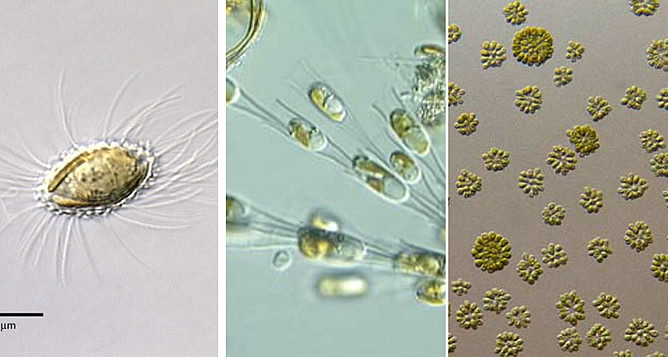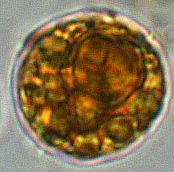| Cell | Chlorophyll | Pigments | Membranes | Thylakoids | Storage | Covering | Flagella |
|---|---|---|---|---|---|---|---|
| Eukaryotic | a, c1, and c2 | Fucoxanthin or vaucheriaxanthin | 4 | 3 | chrysolaminarin | cellulose, silica, alginate | 2 unequal |

| Jason Oyadomari | Jason Oyadomari | Jason Oyadomari |
The chrysophytes, or golden algae, are a group of single celled, colonial flagellates, or filamentous forms with golden yellow pigments.
Chrysophytes are distinguished from other algae by their two flagella (also called undulipodia), which are unequal in length. The Chrysophytes also possess characteristic photosynthetic and accessory pigments that give them a golden yellow color. Cells are found primarily in freshwater habitats and either live alone as single cells, or joined together in colonies, filaments or thalli (leaf-like forms). The chrysophytes obtain energy through photosynthesis, although many species are also able absorb dissolved organic carbon as a food source. Chrysophytes characteristically contain the different chlorophyll molecules: a, c1, and c2. Cells store their excess energy in chrysolaminarin, a type of carbohydrate. Most cells are brown or golden in color because of their accessory pigment, a molecule that absorbs light, called fucoxanthin. Blooms of some species may produce unpleasant tastes and odors in drinking water.
Structure
During at least one point during their life history, cells have two unequal undulipodia (flagella). The undulipodia are termed “heterokont”, which refers to the different lengths of each undulipodium. Members of this group are called stramenopiles, or “straw bearers”, because each undulipodium is covered with tiny, hollow hairs (also called mastigonemes). Scientist’s understanding of the common ancestry of members of this group is based on the tiny, hollow hairs of the undulipodia, as well as similarity in ribosomal RNA gene sequences.
Many of the chrysophytes are able to use silica dissolved in the surrounding water to make coverings, or shells. For example, Synura is a colonial chrysophyte that possesses elaborate silica scales. Many of the chrysophytes are able to survive cold or dry conditions by forming a special cyst. These cysts may be thick silica structures that can survive for many years until favorable conditions allow them to generate and form new cells.
Golden algae in Rocky Mountain Lakes
In the Rocky Mountains, the chrysophytes are an important part of the phytoplankton, or free-floating algae, in many high elevation lakes. Hydrurus is a filamentous chrysophyte that may be very abundant in cold mountain streams, particularly in the fall.
25 taxa shown below, 24 of which appear in at least one sample.
| Name | Basionym | Synonyms | Lakes | Samples | Region* | ID |
|---|---|---|---|---|---|---|
| Bitrichia (Diceras) phaseolus | 1 | 2 | RMNP, | 3001 | ||
| Chromulina minutissima | 3 | 9 | RMNP, | 3002 | ||
| Chromulina sp. | 1 | 69 | SLW, | 3003 | ||
| Chroomonas sp. | 1 | 9 | RMNP, | 3005 | ||
| Chrysococcus cordiformis | 1 | 4 | RMNP, | 3006 | ||
| Chrysococcus sp. | 2 | 99 | RMNP, SLW, | 3007 | ||
| Chrysococcus varius | 0 | 0 | 3008 | |||
| Chrysolykos planctonicus | 1 | 4 | RMNP, | 3009 | ||
| Desmarella sp.(moniliformis?) | 1 | 3 | RMNP, | 3010 | ||
| Dinobryon bavaricum | 1 | 5 | RMNP, | 3011 | ||
| Dinobryon borgei | 1 | 1 | RMNP, | 3012 | ||
| Dinobryon cylindricum | 2 | 2 | RMNP, | 3013 | ||
| Dinobryon cylindricum var. alpinum | 2 | 11 | RMNP, | 3014 | ||
| Dinobryon divergens | 3 | 68 | RMNP, | 3015 | ||
| Dinobryon pediforme | 1 | 3 | RMNP, | 3016 | ||
| Dinobryon sociale var. americanum | 1 | 4 | RMNP, | 3017 | ||
| Dinobryon sp. | 3 | 53 | RMNP, SLW, | 3019 | ||
| Dinobryon statospore | 1 | 2 | RMNP, | 3018 | ||
| Kephyrion spirale | 1 | 4 | RMNP, | 3023 | ||
| Mallomonas akrokomas | 1 | 1 | RMNP, | 3026 | ||
| Mallomonas akrokomas var. parvula | 1 | 2 | RMNP, | 3024 | ||
| Mallomonas sp. | 2 | 6 | RMNP, | 3020 | ||
| Oochromonas sp. | 1 | 1 | RMNP, | 3025 | ||
| Pseudokephyrion entzii | 1 | 5 | RMNP, | 3021 | ||
| Unicellular flagellate | 3 | 14 | RMNP, | 3022 |
Region:
RMNP = Rocky Mountain National Park, CO
SLW = Silver Lakes Watershed, CO
Images are not scaled. An individual that looks bigger than its neighbors might actually be smaller. All images were made to fit within an area of 360px high and 200px wide.
 Chromulina sp. Length 1-2 µm Width 0.5-1.0 µm |
 Chrysococcus sp. Length 10-15µm Width 10-15 µm |
 Dinobryon sp. Length 3-5 µm Width 1-1.5 µm |
Representative images missing for: Bitrichia (Diceras) phaseolus | Chromulina minutissima | Chroomonas sp. | Chrysococcus cordiformis | Chrysococcus varius | Chrysolykos planctonicus | Desmarella sp.(moniliformis?) | Dinobryon bavaricum | Dinobryon borgei | Dinobryon cylindricum | Dinobryon cylindricum var. alpinum | Dinobryon divergens | Dinobryon pediforme | Dinobryon sociale var. americanum | Dinobryon statospore | Kephyrion spirale | Mallomonas akrokomas | Mallomonas akrokomas var. parvula | Mallomonas sp. | Oochromonas sp. | Pseudokephyrion entzii | Unicellular flagellate |

